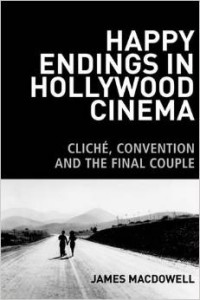Indie films often mark their difference from the Hollywood mainstream through their resistance to the kinds of happy endings associated with studio films. That Hollywood films always have, or have had, such endings, or that they are as simplistic and/or socially conservative as has often been assumed, is questioned, however, in an excellent new book by James MacDowell, Happy Endings in Hollywood: Cliché, Convention and the Final Couple (Edinburgh University Press, currently only in hardback but due out in paper in December).
MacDowell’s argument, in a nutshell, is that the happy ending – as it is often characterised – does not exist. Hollywood often employs happy endings, but these are, specifically, plural in nature, and variable in character along numerous axes, he suggests, rather than conforming to the kind of singular Platonic ideal (an ideal generally denigrated in critical commentary) that is often implied. In fact, he argues, the exact nature of happy endings has rarely been examined in detail, so familiar is the notion of the form as a negative point of reference. To correct this, in a valuable contribution to films studies on several fronts, he demonstrates the existence of varying forms and degrees of ‘happiness’ and ‘ending’ in Hollywood, via a study that focuses particularly on these issues as they apply to the formation of the final couple in the genres of romantic melodrama and romantic comedy (along the way, he offers valuable consideration of a number of dimensions of film study more generally, including issues relating to the ideological implications, or otherwise, of textual features of this kind).
That non-Hollywood films should mark their distinctive character through denial of what is associated with the clichéd Hollywood version is actually little affected by this argument. The whole point is often to mark difference rhetorically from that which is associated with the mainstream, rather than necessarily from a closely examined notion of the latter. In its general currency as a cultural topos and reference point, MacDowell suggests, the notion of the Hollywood happy ending is precisely a taken-for-granted assumption – exactly the kind of assumption against which alternative forms are often defined or celebrated. For all its sins, one of the fates of Hollywood is often to be subjected to over-simplified criticism. The notion of the clichéd happy ending is one of many ways in which studio films – either individually or collectively – are often accused of degrees of aesthetic crudeness, standardisation or simplicity that are far from always substantiated by close analysis. It is one of many ways in which a notion of ‘the mainstream’ is constructed discursively, as a negative point of reference for other kinds of cinema.
This is part of a much broader process through which notions of ‘art’ and other forms of ‘higher’ culture – including, potentially, art and indie film – are articulated on the basis of the denigration of  other forms, those relegated in prevailing cultural hierarchies to ‘lower’ or ‘popular’ status. This underlying basis of the manner in which forms such as indie film are attributed cultural value is one in which I’ve become increasingly interested and is very much to the fore in the book I’m currently about to finish, Quality Hollywood: Markers of Distinction in Contemporary Studio Film (due out from I.B.Tauris in 2015). Hollywood itself contains a strand of films that mark themselves out as ‘superior’ to the studio norm, in culturally-hierarchical terms – the kinds of films likely to be on display in the coming months, during the build-up to next year’s major awards season. One key dimension of these can be an inclusion of less-than-entirely happy endings.
As MacDowell suggests, a dominant critical tendency has been only to consider non-happy endings in the context of what amounts to an active subversion of the norm. His argument is that the situation is much less black-and-white; that endings that depart from the fullest sense of the ‘happy’ need not clearly be marked as ‘alternative’ or ‘subversive’ but that the Hollywood ending itself contains a great deal of variety. It’s notable, though, that some of the examples he considers in these terms are marked by their location outside the Hollywood mainstream – principally, the Indiewood, speciality division, release Eternal Sunshine of the Spotless Mind (2004) and the more fully independent Shortbus (2006) – the latter, unsurprisingly, the most radical in the gender politics of its collective happy ending. What MacDowell demonstrates most convincingly, however, is that, despite differences than can be mapped, in this way, in terms of position across the industrial spectrum, a wide variety of nuances can still be found even within solidly studio productions and even, to a substantial extent, within those of the classical era made under the restrictive aegis of the production code.
The moral for those who study indie films (or others that mark themselves out as different from a notion of the mainstream, whether within Hollywood or in more radical forms of art cinema) is to beware of partaking in over-simplified characterisations of the Hollywood point of comparison. The manner in which such characterisations are discursively formulated more widely within our culture, however, and the historical roots of this, is a topic worth of further study, one key manifestation of which is very effectively identified in this book.

